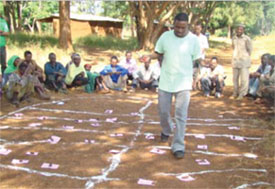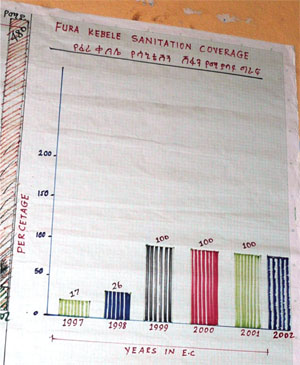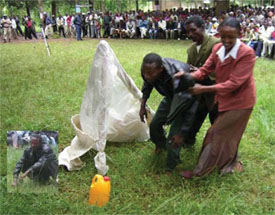21.4.2 Community-Led Total Sanitation (CLTS)
CLTS aims to bring community-wide elimination of open defecation by raising awareness and promoting affordable technology options. NGOs, multinational organisations and government health programmes in many countries in developing regions of the world (including Ethiopia) are adopting this approach. It has become the most successful community approach to total sanitation.
Like PHAST, the core principle of CLTS is that it is a community-driven approach. The role of outsiders, possibly including you as a Health Extension Practitioner, is to guide the community to assess its sanitation situation, determine a strategy for improvement, implement the solution and develop a way to measure success.
CLTS relies on the skill of the facilitators using a set of activities and demonstrations to communities to study their situation (Figure 21.4). This includes open defecation patterns in their village and faeco-oral contamination that occurs in their community.

CLTS encourages community members to change by going through an ‘ignition’ moment when they are ‘triggered’ into action, for example, the moment when they collectively realise that open defecation amounts to eating each others’ faeces. In the ‘ignition’ process, the facilitator talks to a gathering of all community members (including men, women, children, youth and elderly) in direct language about sanitation in a way that is normally taboo in the community. By engaging them in frank and transparent discussions, for example asking them to assess the amount of faeces they produce, you will ‘trigger’ them by creating a sense of shame and disgust, which in turn mobilises the community to take immediate action to end open defecation. The facilitator will guide (not prescribe!) the participants in developing their own low-cost latrine designs and a sanitation plan of action for their villages. Hopefully, with the help of locally available expertise and resources, the participants can immediately start constructing latrines.
As part of the CLTS process, activists and enthusiastic members of the community called ‘natural leaders’ should emerge and take the lead. Natural leaders will play a vital role in encouraging communities to adopt and go through with the planned activities. These natural leaders could subsequently become ‘consultants’, triggering and providing engagement and support to communities other than their own.
School-Led Total Sanitation (SLTS) is a related form of community approach to total sanitation. You can engage school teachers and students in similar sanitation activities with the aim to clean up the school environment and promote hygiene among school children and staff. School sanitation clubs can be actively engaged in SLTS. Though the targets are slightly different, the techniques are similar to the CLTS approach.
In CLTS, it is very important for you to consider and understand the cultural and contextual differences between communities. There might be incidences when the community members may be angry or sensitive to discussions at times of triggering and when they are ignited. You must know how to handle these events in order to get back on track. So instead of adopting the whole practice of CLTS applied elsewhere, you may need to adapt it to fit your community’s cultural and social conditions.
Box 21.4 Case Study: CLTS in Fura kebele
Fura kebele declared Open Defecation Free (ODF) status in September 2, 2007.
Fura is in Shebedino Woreda in the Southern Nations Nationalities People’s Region of Ethiopia. Like other areas of Ethiopia, Shebedino suffered with open defecation in the fields, around the home, on footpaths and in the bush. Plan Ethiopia Shebedino Programme, an NGO, technically facilitated the implementation of CLTS in this kebele in February 2007. Local leaders and the Health Extension Workers and health promoters were first trained in CLTS approaches and then community members were involved. With CLTS training, the participants were overwhelmed with shame and disgust because of their open defecation practices. They promised to end open defecation and they achieved this within four months. CLTS mobilised community residents to identify their problems and design their own solutions to improve hygiene and sanitation behaviour. CLTS also facilitated development of local rules, such as ‘any person caught defecating in the open, will be forced to shovel and carry his faeces to the nearest latrine’. All households, 1265 of them, had latrines and 7 communal latrines were constructed along the main road to the market place to be used by passers-by. About one third of household latrines were constructed after CLTS was introduced.
The progress towards total sanitation and the year when 100% coverage was achieved is shown on a chart on the wall of Fura Health Post (Figure 21.5).
 | Figure 21.5 Wallchart at Fura Health Post showing the rapid increase in sanitation coverage in the kebele. 100% coverage was achieved in 1999 in the Ethiopian calendar, 2007 in the European calendar. (Photo: Pam Furniss) |
Open Defecation Free was declared and celebrated on September 2, 2007. Project personnel, local leaders and the kebele residents, in total about 500 people, participated in the celebration which was organised in the compound of Fura School. Poems, drama, songs and posters that condemn open defecation were presented. One of the dramas (Figure 21.6) focused on the need to punish anyone who defecates in the open air.
 | Figure 21.6 Community members demonstrating in drama how they punish open defecators. |
Slogans and sign boards that strongly promote the importance of hygiene and sanitation adorned the school compound. One slogan read: ‘Fura: the kebele where all households constructed pit latrines on their own initiative, and where all use latrine, saying no to open defecation’. Other slogans read: ‘Bury faeces not people’; ‘Fura enters the New Ethiopian Millennium open defecation free’. Community members were very happy about the recognition they had for being Open Defecation Free. They were highly committed and promised to keep their kebele ODF in the future. Neighbouring kebele leaders and Health Extension Workers were invited to share the experience of the Fura ODF event. This resulted in the establishment of school clubs, advocating CLTS in churches and mosques, and establishment of CLTS Committees in other communities.
21.4.1 Participatory Hygiene and Sanitation Transformation (PHAST)
